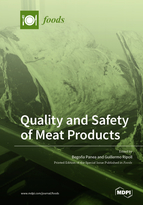Quality and Safety of Meat Products
A special issue of Foods (ISSN 2304-8158). This special issue belongs to the section "Meat".
Deadline for manuscript submissions: closed (15 April 2018) | Viewed by 80502
Special Issue Editors
2. Agrifood Institute of Aragon-IA2 (CITA-Zaragoza University), Avda. Montañana 930, 50059 Zaragoza, Spain
Interests: meat science; shelf-life; color; texture; sensory analysis; consumer test
Special Issues, Collections and Topics in MDPI journals
Interests: animal science; animal production; meat quality; meat products; acceptability of meat and meat products; the shelf-life of meat and meat products; ruminant production systems; ultrasound; immunocastration; animal science; cattle; consumers; near-infrared spectroscopy (NIRS); carcass quality
Special Issues, Collections and Topics in MDPI journals
Special Issue Information
Dear Colleagues,
The Rome Declaration on World Food Security includes the right of everyone to have access to safe and nutritious food, and the World Summit on Food recognized the link between food safety and quality. In 2020, the world's population will surpass 7.5 billions of people and the main increases will be in developing countries. It is well known that development stimulates an increase in the demand for high-quality protein, and, among candidates food, is, undoubtelly, meat and meat products. Thus, this increase in population poses great food challenges in general, and to the meat industry in particular. To meet the needs of these populations, we will have to reorganize production systems and the distribution of food and some of the changes will bring potential problems to food safety and nutritional quality. Food-borne diseases are a major problem around the world, both in regards to human suffering and with respect to economic costs. Scientific advances have allowed to better know the nutritional characteristics of foods and their effects on health. This means that a large proportion of consumers are much more conscious with respect to what they eat, and their demands for quality food. Food quality is a complex term that includes, in addition to safety, other intrinsic characteristics, such as appearance, color, texture and flavor and also extrinsic characteristics, such as labelling or certification. Scientists have much to contribute to this new scenario. Our role will be critical to ensure future population health, nutrition and sensory-acceptable foods.
Dr. Begoña PaneaDr. Guillermo Ripoll
Guest Editors
Manuscript Submission Information
Manuscripts should be submitted online at www.mdpi.com by registering and logging in to this website. Once you are registered, click here to go to the submission form. Manuscripts can be submitted until the deadline. All submissions that pass pre-check are peer-reviewed. Accepted papers will be published continuously in the journal (as soon as accepted) and will be listed together on the special issue website. Research articles, review articles as well as short communications are invited. For planned papers, a title and short abstract (about 100 words) can be sent to the Editorial Office for announcement on this website.
Submitted manuscripts should not have been published previously, nor be under consideration for publication elsewhere (except conference proceedings papers). All manuscripts are thoroughly refereed through a single-blind peer-review process. A guide for authors and other relevant information for submission of manuscripts is available on the Instructions for Authors page. Foods is an international peer-reviewed open access semimonthly journal published by MDPI.
Please visit the Instructions for Authors page before submitting a manuscript. The Article Processing Charge (APC) for publication in this open access journal is 2900 CHF (Swiss Francs). Submitted papers should be well formatted and use good English. Authors may use MDPI's English editing service prior to publication or during author revisions.
Keywords
- food challenge
- safety
- nutritional quality
- sensory quality
- meat








